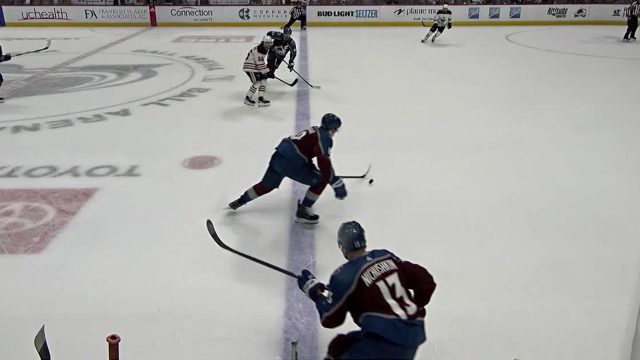
When Cale Makar picked off a pass, crossed the Edmonton Oilers’ blue line and rifled a shot past Mike Smith at the end of the first period on Tuesday, the Oilers quickly challenged — because clearly Colorado Avalanche forward Valeri Nichushkin was offside… right?
Not quite.
Despite much of the hockey world expecting the goal to be overturned since Nichushkin was still in the Oilers’ zone when the puck crossed the blue line, the officials came out after a lengthy review to announce the call stood. The play onside, good goal, and the Avalanche took a 3-2 lead into the first intermission.
So why did the goal stand? How was it onside? Here’s an explanation.

A delayed offside occurs when an attacking player(s) crosses the offensive blue line before the puck, but the defending team is in position to bring the puck out of the zone without delay, or the attacking player(s) are in the process of exiting the zone.
However, according to rule 83.3, the delayed offside violation can be nullified under two conditions:
i) All players of the offending team clear the zone at the same instant (skate contact with the blue line) permitting the attacking players to re-enter the attacking zone, or
ii) The defending team passes or carries the puck into the neutral zone.
The rule goes on to explain that if, during the course of the delayed offside, “any member of the attacking team touches the puck, attempts to gain possession of a loose puck, forces the defending puck carrier further back into his own zone, or who is about to make physical contact with the defending puck carrier,” the linesman will stop play for the violation.
This possession condition of the rule carries significance for Makar’s goal.
As Makar intercepts the puck in the neutral zone, he then pushes the puck across the blue line with one hand, while Nichushkin is still in the Oilers’ zone.
However, according to the NHL’s ruling on the goal, pushing the puck forward did not constitute an attempt at gaining possession, and he does not actually cross the blue line and take control of the puck in the offensive zone until Nichushkin has tagged up and come back onside. Once Nichushkin was deemed to have properly exited the zone, Makar gained sufficient control of the puck for it to be considered possession, making his zone entry and ensuing goal onside.

“It was determined that Colorado’s Valeri Nichushkin legally tagged up at the blue line before Cale Makar entered the offensive zone with the puck on his stick. Makar made contact with the puck in the offensive zone after Nichuskin was in an on-side position,” read an official explanation from the NHL.
Either Makar is extremely luckily, or is his hockey IQ is even further off the charts than we thought. What was his intention on the play?
“I knew they were trying to get out of the zone. My instinct was to try to give them as much time as possible,” Makar said after the game.
To add insult to injury, the Oilers received a penalty for the failed coaches challenge, and the Avalanche buried goal on the ensuing power play early in the second period.




